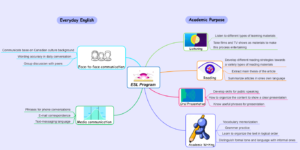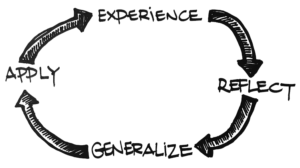ESL Develop English Speaking, Listening, Reading and Writing Skills
EDCI 335
Pod 5
Carol Liu
Caroline Wang
Savannah Miao
Course Description: This course introduces a project-based instructional approach in second-language learning. Students will develop their English skills through real world tasks and situations. This course is created with the intention of providing learners (CLB 8) the opportunity to develop communication, listening, reading comprehension and writing skills in English. Throughout the course, learners need to use their receptive skills (listening and reading) as well as their writing and presentation skills to finish a term project. At the beginning of the class, each student will choose a book to read over the term. At the end of the term, each student is going to do a presentation about the book that they read and draw a poster about one plot in the book and write the book summary on it. Also, while students are doing their presentation, the rest of the students should take notes about what happened in other’s book. Each week students should be able to read one chapter and write a summary about it. In each class, students are going to learn knowledge through the real world problem. (e.g. students are going to learn some evaluate language use through reading the movie review online.)
Concept Analysis:
- Learning English as a second language is defined in the literature as learners of English language development, in comparison to peers, for academic purposes in the schooling context (Baker, 2006; Ontario Ministry of Education, 2005; Peregoy & Boyle, 2008; Perez & Holmes, 2010). Also ESL could be a multicultural concept, students from elsewhere come together to learn the same language and share their country’s culture in a new language to their peers (Berlin, 2012).
- English has been the most commonly used language in many schools, even though the official language of that region is the other one. For example, French is the official language in Montreal, but the lectures are given in English in the universities. To respect the diversity of cultural background, professors and students have to speak English because it is the most common language that the majority of them can speak. With the unified language, it is easier for everyone to communicate with others in the class. In addition, it is more convenient for instructors to organize the class. Thus, learning English could be very helpful under a variety of circumstances.
- However, there are some misconceptions on English learning. One thing needs to be mentioned is that people tend to believe the second language has to be learned since early childhood; because it is the best time to acquire new skills. Although kids might learn new things faster, people of any age are able to learn and obtain another language. A person in his middle adulthood could also make an achievement on English learning. Age cannot determine whether you will learn English well or not.
- Practice is the most essential feature of English learning. By reading more english articles, both reading comprehension skill and writing skill will be improved. Similarly, having more conversations with other English speakers could also enhance one’s speaking and listening skills. Without the practice, it is difficult to make progress on the learning of this second language. Because the subject of the learning is a language, communication and feedback could also be considered as essential features. Communicating with others will not only let learners practice more, but also provide the feedback through the process. The feedback reflects learning outcomes and it will let learners notice whether they use the words appropriately or not.
- For accidental features of learning English, one of them could be the talent for language. Language talent is certainly very useful during the study process, but it is not a necessary element for language learning. A person without talent could also achieve success in mastering a language through hard work. Another very similar accidental feature is the language environment. Being in an absolute English environment would be very helpful for learning English from many aspects. It will allow learners to make great improvement in a short time. However, this does not mean that improvement cannot be made in a non-English speaking environment.
Learning Outcomes:
After completing this course, our learners are expected to:
- Achieve success in future academic learning which base on an English learning environment. As the main learning outcome, we will achieve it by enhancing learners’ fluency and accuracy of English using during the study process. Learners will be able to keep up with any school content from listening, oral presentation, reading and academic writing four aspects with no language barrier problem.
- Be able to apply English into real-world social situations in different forms. In addition to the academic purpose, learners will also be familiar with how to respond and complete daily life conversations in English, and be knowledgeable of some culturally influenced social situations based on the Canadian culture. Moreover, the learners will be knowledgeable of how to talk and meet online(phone call, texts, e-mail etc.).
Sub-topics Mindmap:

Resources:
- ‘Grey literature’:
Recommended TV series:
Stranger Things
Friends
Killing Eve
The Morning Show
- Technology Tools:
Kahoot
- Websites:
ESL Library https://www.esllibrary.com/courses
- Others
Handouts that instructor created for each class
Work Allocation of Interactive Learning Resource:
1-4 (Caroline), 5-8 (Carol), 9-13 (Savannah)
- An overview of the resource
- A description and rationale for the learning theory upon which your resource will be based (behaviorism, cognitivism, constructivism)
- A description and rationale for the learning design you chose (inquiry, project-based, direct instruction, etc)
- A description of your learning context (K-12, higher ed, corporate, individual, etc)
- 2-4 learning outcomes (copied or revised from your blueprint)
- Brief commentary about each topic and activity
- One interactive activity for each learning outcome/topic based on a resource aligned with that topic (blog post, video, article, etc)
- An overview of your assessment plan.
- An overview of your plans to design for inclusion of diverse learners (choose two from the list above, and specify in your resource).
- A rationale for your technology choices.
- Links to each peer review of your resource
- A rationale for why you did or did not incorporate your peers recommendations into your final resource
- A bibliography or reference list of all resources cited and/or required for your learners
References:
Baker, C. (2006). Foundations of bilingual education and bilingualism (4th ed.). Clevedon, UK: Multilingual Matters LTD.
Berlin, L. N. (2005;2012;). Contextualizing college ESL classroom praxis: A participatory approach to effective instruction (1st ed.). Mahwah, N.J: Lawrence Erlbaum. doi:10.4324/9780203826393



